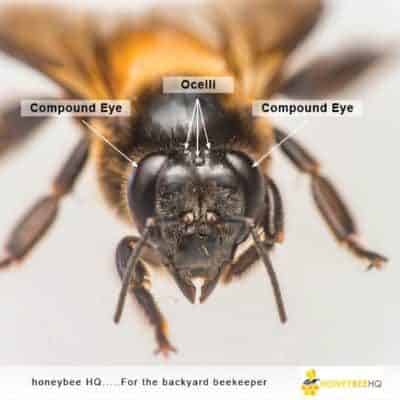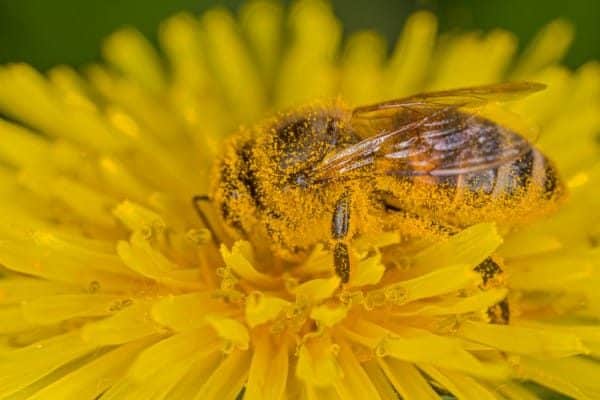Bee vision is one of the wonders in the natural world. Bees are actually able to see color much faster than a human being and differentiate individual flowers even when flying at a high speed. They can see in three dimensions, assess depth, and evaluate a distance.
Their unique ability to see ultraviolet light helps them to distinguish flowers with ease, which assists them in seeking out nectar. Amazingly many patterns on the flowers that aren’t able to be seen by humans are visible to honey bees. Bees are especially attracted most to purple, blue, and violet colors.
This brings us to our question, how many eyes do bees have?
Bees have five eyes, two large compound eyes, and three simple eyes called ocelli. The ocelli, are on top of the bee’s head in a triangular pattern. The compound eyes are on each side of their head and have thousands of tiny lenses (facets). Facets help the bees to detect color, patterns, and movements.

But wait; do bees see all the colors that we see? Do they see at night? Do they see shapes? Read on to discover more about these amazing and extraordinary creatures.
The Eyes of a Bee
As indicated earlier, bees have two sets of eyes. The simple eyes collect and focus light through a single lens. The bees use ocelli to orientate themselves towards the sun. The simple eyes also help to evaluate the magnitude of light and to maintain stability while navigating.
Studies show that the lense of a simple eye is more sensitive than a single ommatidium of a compound eye. Although they are single-lensed, they have many sensory cells.
The two large compound eyes are the most visible, located on the sides of the bees head. Each compound eye consists of lots of individual lenses (ommatidia) which lie at different angles. Their numbers range between 1000 and 16000 depending on the bee species.
The video below has some great vision of a bees compound eye under a microscope. You can see the individual facets making up the compound eye.
It is important to note that a larger eye can have more ommatidia, with larger facets than a smaller eye. Each ommatidium has its lens, cones, and cells that collect information about the bees surrounding at slightly different angles. They act as separate sensory devices.
Bees see the world differently than we see. The ommatidia contain three types of photoreceptors, which can see blue-green and blue-violet colors. They are also able to recognize ultraviolet light, which humans can’t. Bee’s cant however see the color red, it actually appears black to them.
Ultraviolet patterns on flower petals act as visual guides for bees to direct them where the nectar is. Like bees, human beings also have three receptors, which allow them to see blue, green, and red.
Bees’ eyes also have a unique ability to detect movements. They can identify movements as quickly as a 1/300th of a second. Humans can only recognize movements divided by 1/50th of a second. However, the bees compound eyes are nowhere near as good as human eyes at picking up details from the same distance. They see these objects as mosaic images.
In addition to their ultraviolet vision, the bee’s compound eyes are also able to detect polarized light. This helps them to navigate using the position of the sun. Surprisingly the bees can use polarized light to find direction even in the absence of the sunshine.
According to Karl von Frisch’s studies on the navigation of a honey bee, he established that the sun is the favorite way for the bees to find direction. They navigate by the polarization pattern or by the Earth’s magnetic field only when the sky is cloudy or inside a dark hive. Other insects with five eyes include wasps, dragonflies, and glass hoppers.
Do Bees See at Night?
Most people tend to think that all bees are only active during the day. This is far from the truth! Although most bees are diurnal, some species mainly in the tropical areas start their day after sunset. Examples of these are Apidae and Genus Apis. Both species are honey bees and can forage all night in the presence of an adequate moon.
For the nocturnal species, the simple and compound eyes have evolved to become relatively larger due to limited light available at night. The latter also contains larger numbers of ommatidia than their diurnal relatives.
Some species like the giant Indian carpenter bee can forage at very dim light levels due to their supersized eyes. Apart from their giant ocelli, they have huge ommatidia facet lenses and huge photo photoreceptors.
Why do some bees become nocturnal? In areas where you find these species, many plants or trees species have flowers that open at night. Another reason is due to low competition from other bees and insects at night. Nocturnal bees can see polarized light and detect the landmarks around the surrounding.
Bees Ability to Detect Polarized Light
Polarized light from the sky displays a vast pattern, which is linked to the sun’s position. Honey bees are capable of detecting the skylight polarization and adopt it as a guide in their foraging errands. They will then communicate to other bees about a food source.
When a honey bee discovers flowers with nectar, she returns to the hive, performs a special dance (waggle dance) to inform the other bees where it is by analyzing polarized ultraviolet light.
Interestingly, the waggle dance informs of both the direction and the distance to the flower. The distance is conveyed by the duration of the dance. By dancing more slowly, the bee implies that the distance is greater!
But, what happens when it is cloudy? They still navigate through by use of special photoreceptors in their eyes. Real flower petals display polarized patterns that are invisible to humans but are visible to the bees. This helps them to identify such flowers. About half of the flower species face downwards, so their polarized areas are well visible to the bees.
Do Honey Bees See Moving Objects Better?
Have you ever wondered why bees are more likely to attack those who are running? Honey bees can detect moving objects better than static ones, unlike humans who see stationary objects better.
They are also able to judge distances better while flying. This is because their vision is blurry. Their clarity is 1/60th of human eyesight. They see human faces in a fragmented and blurred way.
They are more likely to visit flowers that are being shaken by the wind. They can recognize 3D images in flight. Bees also detect the slightest movement in 360 degrees and will percieve any looming danger around them. Human beings are only able to see in 180 degrees.
How Do the Hairs on Bees Eyes Help Them?
Bees’ eyes are encircled by a dense layer of hair. These help them to steer in windy weather. The nerve extensions within the hair help to sense even the slightest force of the wind and relay the information to the brain, enabling them to move in the right direction.
As they forage, their bodies get covered with pollen grains, which is one of their methods of collecting pollen. The hairs on their eyes also get covered with pollen, these hairs protect the eyes from direct contact with pollen, which can impair their vision.

They can’t however, fly and navigate their way back to the hive with pollen on the hairs. What do they do? They remove the pollen from their hair by transferring it to the pollen baskets situated on their hind legs. Amazing!
The Wrap Up
Bees are crucial to an ecosystem and are considered as keystone species due to their role in pollination. This is made possible by the extraordinary eyesight that they possess. Their five eyes, both the simple and compound eyes play unique roles in the bee’s navigation and identification of flowers and nectar.
Although bees may not be able to see more detailed information that we do, their eyes excellently serve their needs and the needs of the environment.
